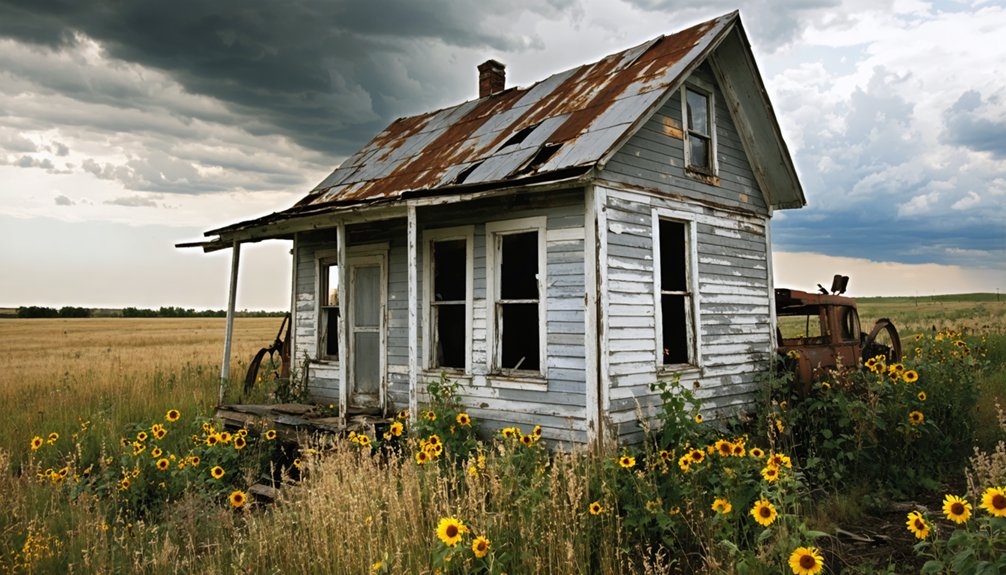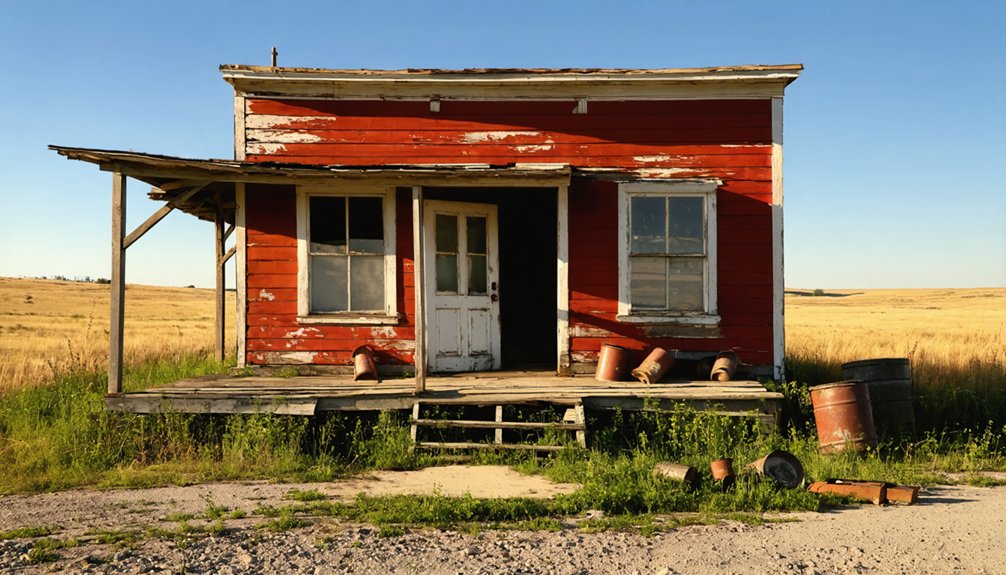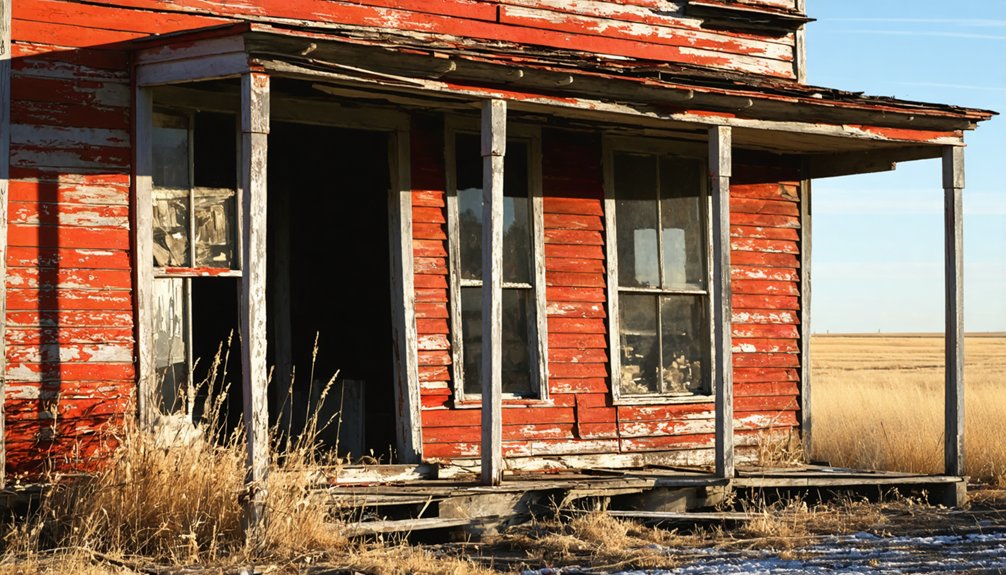You’ll find Huseboe’s remains in eastern South Dakota’s prairie landscape, where it once thrived as a homesteading community in the late 1800s. The historic general store served as the town’s vibrant hub, hosting everything from township elections to social gatherings, while the nearby schoolhouse educated local farm children. Though now abandoned, you can still spot the weathered store building and schoolhouse foundation, telling stories of pioneer life on the American frontier. The site’s rich history holds countless tales of survival, community, and change.
Key Takeaways
- Huseboe was established during Dakota Territory settlement, anchored by its general store which served as the community’s primary commercial hub.
- The town’s historic general store building still stands but is abandoned, serving as a physical reminder of rural South Dakota’s past.
- Huseboe School played a vital role as both educational facility and community gathering space before the town’s decline.
- Access to Huseboe is limited by deteriorated dirt roads, requiring high-clearance vehicles and favorable weather conditions.
- The ghost town faces preservation challenges due to weather damage, limited funding, and lack of state park protection.
The Birth of a Prairie Settlement
Three major forces converged to establish Huseboe and other prairie settlements in Dakota Territory during the 1860s and 1870s.
First, the Homestead Act of 1862 offered you 160 acres of land for minimal fees, opening vast opportunities for European immigrants seeking a new life.
Second, railroad companies aggressively promoted Dakota as a paradise while laying tracks that would connect your future homestead to national markets.
Third, the Dakota Land Company acquired territory from the Yankton Sioux, paving the way for white settlement.
You’d face significant prairie life challenges – many settlers chose locations near rivers for water access and grouped near forts for protection.
Like the Norwegians near Sioux Falls, ethnic communities formed tight-knit settlements, often establishing churches as cultural anchors while tackling the demands of frontier living.
The Norwegian population grew dramatically from just 129 settlers in 1860 to become one-third of residents by 1889.
Life at the General Store
At the Huseboe general store, you’d find yourself at the center of daily commerce, where the early morning hustle began with farmers bartering grain for essential supplies and continued through the evening with townspeople purchasing dry goods and groceries.
The store’s legacy continues today as the oldest store in South Dakota, preserving a snapshot of traditional rural commerce. You could witness the store’s crucial role as a community hub, where locals gathered around the coal-burning furnace to share news and discuss everything from crop prices to upcoming social events.
During Saturday’s extended hours, you’d see the store transform into a bustling social center, with multiple languages echoing through the aisles as diverse community members conducted their weekly shopping and lingered for conversation.
Daily Trade and Commerce
During Huseboe’s peak settlement years, John Huseboe’s general store stood as the economic cornerstone of daily commerce in Corson County, South Dakota. You’d find essential supplies ranging from food staples to farming tools, all managed from the store’s unique layout with upstairs living quarters that guaranteed round-the-clock operation. The Mains brothers reside in those living quarters today.
The store’s barter systems adapted to the frontier economy, letting you trade local produce or livestock for merchandise when cash was scarce. Seasonal goods reflected the farming cycles, with stock carefully managed through harsh winters and agricultural off-seasons. Like many frontier establishments that became ghost town sites, the store eventually fell into disrepair as economic conditions shifted.
You’d connect with neighboring farmers and ranchers who’d gather to exchange news while negotiating prices and credit terms. Despite primitive road networks and weather challenges, the store maintained its crucial role as the lifeline between isolated homesteads and distant markets.
Community Hub Activities
Beyond its mercantile role, the general store stood as Huseboe’s social heartbeat, where community life flourished in countless ways.
You’d find township elections and official meetings taking place here, alongside religious services that brought neighbors together in spiritual fellowship. The store’s dual-purpose design, with living quarters upstairs, guaranteed the storekeepers remained at the center of community events.
The store was a natural gathering spot where locals would share stories, including tales from the local liars club about haunted properties in the region.
Working in tandem with the nearby Huseboe School, the store created a vibrant hub of activity. Today, it stands as one building remaining among the ruins of this historic settlement.
Together, these landmarks strengthened social bonds through entertainment gatherings and club meetings. The store’s legacy, established by settler John Huseboe after the Standing Rock Reservation opening, continues to tell the story of how rural South Dakotans built lasting connections in their pioneering community.
Education and Community Gatherings
The Huseboe School‘s brick walls stood as both an educational cornerstone and social nucleus for the town’s scattered farming families.
You’ll find that dedicated teachers like Pearl Blackstone and Blanche Njos shaped the educational impact on children from progressive farming and ranching settlements that emerged after the Standing Rock Reservation opening.
Beyond classroom learning, you’d have witnessed the school’s crucial role in fostering community resilience. The building transformed regularly to host township elections, local meetings, and religious services. Like many ghost town remnants today, the school building serves as a physical reminder of the community’s past vitality.
While John Huseboe’s general store next door provided everyday necessities, the school offered something equally essential – a place where isolated rural families could gather, organize community clubs, and maintain social bonds despite the challenges of geographic separation and harsh seasonal weather.
Standing Rock’s Legacy
While the Huseboe School served as a gathering place for settlers, its very existence stood on land with deep historical significance.
You’ll find this area was once part of the Great Sioux Reservation, established by the 1868 Treaty of Fort Laramie, which guaranteed millions of acres to the Lakota people, including the sacred Black Hills.
The land’s story reflects a broader struggle for cultural preservation and treaty rights. When gold was discovered in 1874, the U.S. government violated the treaty’s terms, seizing the Black Hills without the required three-fourths consent of adult male Sioux.
The Standing Rock Agency at Fort Yates became an administrative center for the reservation in 1873, overseeing tribal affairs and government relations. The area now encompasses 3,571 square miles of territory across North and South Dakota.
Even today, Standing Rock’s legacy continues through legal battles and protests, as seen in the Dakota Access Pipeline controversy, where the tribe has fought to protect their water resources and ancestral lands from environmental threats.
Daily Life in Early Huseboe

As settlers poured into Brown County between 1879 and 1883, Huseboe’s population swelled from a mere 353 to approximately 8,000 residents, with many newcomers arriving through the land office in Watertown.
You’d find most settlers establishing farms on their 160-acre homesteads, breaking new ground and planting the required ten acres of trees.
Settler traditions emerged from the prairie challenges they faced – building sod houses or wooden structures with limited materials hauled from Kimball, and sharing labor with distant neighbors during significant times.
You’d have to be resourceful, constructing your own buildings and learning to maximize your harvests.
Social connections formed around ethnic and religious ties, though isolation was common due to the vast distances between homesteads until better roads and railways arrived.
The Last Residents
During Huseboe’s final years, you’d find just a handful of devoted residents maintaining their family homesteads amid the town’s crumbling infrastructure. As the buildings deteriorated, many showed missing rooftops and other signs of disrepair.
These last residents, often elderly individuals with deep roots in the community, stayed behind while others left during the economic downturn and Great Depression.
Aging souls clung steadfastly to their hometown, refusing to abandon cherished memories while neighbors fled financial hardship.
You’ll notice these holdouts weren’t driven by financial gain but by emotional attachment to their ancestral properties.
They’d inherited houses from parents or grandparents, choosing solitude over relocation.
While modern amenities grew scarce and nearby towns absorbed local services, these determined souls became unofficial caretakers of Huseboe’s legacy.
They’d travel to neighboring communities for basic needs while preserving local memories and maintaining what remained of their isolated dwellings, surrounded by the silent remnants of a once-thriving town.
What Remains Today

You’ll find the old general store building still standing along Huseboe’s main road, though its weathered walls and missing roof tell the story of decades of abandonment.
The town’s former schoolhouse sits a quarter mile east, its foundation intact but most of its wooden structure having succumbed to the elements.
While the original dirt roads remain passable during dry weather, you’ll need a high-clearance vehicle to navigate the rutted paths that lead to these remaining structures.
Standing Store Building
The weathered wooden store building stands as one of the last vestiges of Huseboe’s brief existence. You’ll find this early 1900s structure, with its architectural significance evident in the large storefront windows and simple wooden plank construction, still maintaining its basic form despite years of South Dakota’s harsh elements.
The building once served as the town’s commercial heart, where locals gathered to purchase supplies and exchange news.
While the roof and walls remain largely intact, preservation challenges mount as each season passes. You can spot signs of decay and partial collapse in certain areas, though the building’s utilitarian design – complete with a practical front porch entrance – continues to reflect its original purpose.
Without protective measures, this tangible link to Huseboe’s history faces an uncertain future.
Abandoned School Structure
Standing since 1893, Huseboe’s weathered school building reflects the deteriorating state of this ghost town’s educational legacy.
You’ll find this abandoned architecture exposed to the harsh South Dakota elements, where prairie winds and severe winters have taken their toll. The structure’s large windows, once designed to illuminate classrooms with natural light, now stand partially vandalized, while graffiti mars both interior and exterior walls.
The building’s facade has begun to bow forward, and its weakening frame speaks to years of neglect.
Despite its decline, this historical education site offers you a compelling glimpse into frontier learning. Set against panoramic prairie views that stretch to the horizon, the schoolhouse remains a poignant symbol of rural South Dakota’s homesteading era, even as it slowly succumbs to time.
Road Access Conditions
Modern attempts to access Huseboe face significant challenges, as no maintained roads currently lead to this enigmatic location. The road conditions you’ll encounter reflect years of abandonment, with access challenges that make exploration difficult without proper preparation.
- Former roadways may have deteriorated into rough dirt tracks
- Vegetation likely overtakes any remaining paths
- Seasonal weather can create impassable mud or snow conditions
- Gates or “No Trespassing” signs might block potential routes
- Emergency services and cell coverage can’t be guaranteed
If you’re planning to investigate Huseboe’s remains, you’ll need to verify current land ownership and obtain necessary permissions.
The absence of documented public access routes suggests most approaches cross private property, making legal entry uncertain without prior authorization from landowners or local authorities.
Ghost Town Tourism and Preservation

While many abandoned settlements across South Dakota have faded into obscurity, Huseboe’s ghost town tourism potential remains largely untapped compared to well-known destinations like Berlin, Nevada.
You’ll find that ghost town preservation here faces typical challenges – weather damage, limited funding, and the need for dedicated maintenance. Without state park protection or organized tourism infrastructure, Huseboe hasn’t experienced the tourism impact seen at more developed ghost town sites.
If you’re interested in helping preserve this piece of South Dakota history, you can support local historical societies or participate in community-driven initiatives.
Digital documentation through photography and 3D scanning offers another way to capture Huseboe’s remaining structures before time takes its toll, contributing to the broader effort of recording America’s vanishing ghost towns.
Frequently Asked Questions
What Was the Average Population of Huseboe During Its Peak Years?
You’ll find population trends suggest around 15-20 residents during peak years, though historical demographics aren’t conclusive. Like nearby settlements Boughton and Bluevale, Huseboe’s ranching community remained particularly small.
Were There Any Notable Crimes or Conflicts Reported in Huseboe?
You’ll find Huseboe’s crime history centers on one tragic well incident where brothers killed their sister’s boyfriend, leading to their imprisonment. Beyond this infamous event, local conflicts weren’t prominently documented.
What Year Did the Last Business Officially Close in Huseboe?
You won’t find an exact business closure date in Huseboe’s town history records. While the general store was the main business, its final operating year remains undocumented in available historical sources.
Did Any Famous People Ever Visit or Stay in Huseboe?
While other South Dakota ghost towns drew famous visitors, you won’t find records of any notable figures in Huseboe’s history. Its historical significance stems from pioneer families and local folklore instead.
What Happened to the Original Huseboe Family After Leaving the Town?
You won’t find reliable records of where the Huseboe family went after leaving their store. Historical documents don’t track their movements or mention what became of their descendants.
References
- https://en.wikipedia.org/wiki/List_of_ghost_towns_in_South_Dakota
- https://www.ghosttowns.com/states/sd/huseboe-lightcap.html
- https://www.southdakotamagazine.com/south-dakota-ghost-towns
- http://cbegeman.blogspot.com/2012/01/ghost-town-hunting.html
- https://www.sdpb.org/rural-life-and-history/2023-08-21/some-black-hills-ghost-towns-and-their-origins
- https://www.sdhspress.com/journal/south-dakota-history-2-2/some-black-hills-ghost-towns-and-their-origins/vol-02-no-2-some-black-hills-ghost-towns-and-their-origins.pdf
- https://www.blackhillsbadlands.com/blog/post/old-west-legends-mines-ghost-towns-route-reimagined/
- https://b1027.com/south-dakota-has-an-abundance-of-ghost-towns/
- https://www.powderhouselodge.com/black-hills-attractions/fun-attractions/ghost-towns-of-western-south-dakota/
- https://history.sd.gov/museum/docs/Immigrants.pdf



